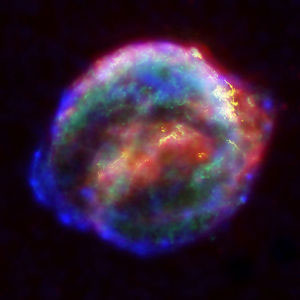“Action replay technique” used to estimate energy of a supernova explosion
 Washington, March 21: By observing the remnant of a supernova and a light echo from the initial outburst, astronomers have established the validity of a powerful new method for studying supernovas, which is literally an “action replay.”
Washington, March 21: By observing the remnant of a supernova and a light echo from the initial outburst, astronomers have established the validity of a powerful new method for studying supernovas, which is literally an “action replay.”
Using data from NASA's Chandra X-ray Observatory, ESA's XMM-Newton Observatory, and the Gemini Observatory, two teams of researchers studied the supernova remnant and the supernova light echo that are located in the Large Magellanic Cloud (LMC), a small galaxy about 160,000 light years from Earth.
They concluded that the supernova occurred about 400 years ago (in Earth's time frame), and was unusually bright and energetic.
This result is the first time two methods - X-ray observations of a supernova remnant and optical observations of the expanding light echoes from the explosion - have both been used to estimate the energy of a supernova explosion.
Up until now, scientists had only made such an estimate using the light seen soon after a star exploded, or using remnants that are several hundred years old, but not from both.
"People didn't have advanced telescopes to study supernovas when they went off hundreds of years ago," said Armin Rest of Harvard University, who led the light echo observations using Gemini.
"But we've done the next best thing by looking around the site of the explosion and constructing an action replay of it," he added.
In 2004, scientists used Chandra to determine that a supernova remnant, known as SNR 0509-67.5 in the LMC, was a so-called Type Ia supernova, caused by a white dwarf star in a binary system that reaches a critical mass and explodes.
In the new optical study, an estimate of the explosion's energy came from studying an echo of the original light of the explosion.
The Chandra data, along with XMM-Newton data obtained in 2000, were then independently used to calculate the amount of energy involved in the original explosion, using an analysis of the supernova remnant and state-of-the-art explosion models.
Their conclusion confirmed the results from the optical data, namely that the explosion was an especially energetic and bright variety of Type Ia supernova.
Because Type Ia supernovas have nearly uniform intrinsic brightness, they are used as important tools by scientists to study the expansion of the universe and the nature of dark energy.
"This is the first case where the conclusions that are drawn from the supernova remnant about the original explosion can be directly tested by looking at the original event itself," said Rest. "We'll be able to learn a lot about supernovas in our own galaxy by using this technique," he added. (ANI)